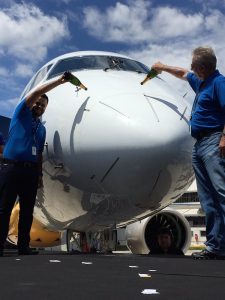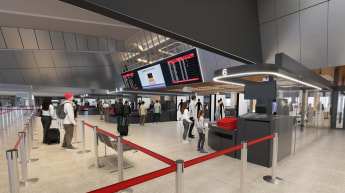
Embraer says the E195-E2 is on track to make its maiden flight later in 2017 after showing off the first completed aircraft at its Brazil headquarters.
The E195-E2 is largest variant of the E2 family of jets and has been designed with a range of 2,450nm when carrying 120 passengers in a two-class layout or 146 in a single-class configuration.
Embraer describes the aircraft, which was unveiled at the company’s São José dos Campos facility on Tuesday (Brazil time) as the “most efficient next-generation commercial jet in the world”.
“With a 20 per cent lower cost per trip and a cost per seat similar to larger aircraft, the E195-E2 becomes the ideal aircraft for regional business growth as well as low-cost business plans and complementing existing mainline fleets,” Embraer Commercial Aviation chief executive John Slattery said in a statement.
The E2 family improves on the current generation E-jets with new aerodynamically advanced, high-aspect ratio, distinctively shaped wings, improved systems and avionics, including fourth generation full fly-by-wire flight controls.
This was expected to result in double-digit reductions in fuel and maintenance costs compared with the current E-jet family. From an environmental perspective, the new aircraft also produced less emissions and less noise. The aircraft will also have a new interior with larger overhead bins and a new first class concept, among other interior improvements.
First flight of the E195-E2 was expected to follow “in the coming months”, with two aircraft to be used for the type’s certification. Its entry into service was due to occur in the first half of 2019.
“The first prototype will be used for the aerodynamic and performance tests,” Embraer said.
“The second prototype, which will also make its inaugural flight by the end of this year, will be used for the validation of maintenance tasks and of the interior.”

The E2 family has secured 275 firm orders as of the end of January. When options, letters of intent and purchase rights were included, the total order book is 690 aircraft.
The other two E2 models were the E175-E2, which seats 80-90 passengers, and the E195-E2 (120-144 seats).
The E190-E2 was currently in flight test and due to be delivered to launch customer Widerøe in the first half of 2018. Meanwhile, the first metal was cut for the E175-E2 in June 2016.
While Embraer was losing a major airline customer in Oceania as Virgin Australia withdraws all 18 E190s by the end of calendar 2017 as part of efforts to cut costs and pay down debt in a bid to return to profitability, its other airline customers in the region have been adding more Embraers to their fleet.
In September 2016, Airnorth picked up its fifth E170 jet, while Jetgo recently took delivery of two ERJ-140LRs for its burgeoning regular public transport network.
Embraer Commercial Aviation vice president for Asia Pacific Mark Dunnachie is upbeat about the company’s prospects in Oceania given the need to replace older aircraft such as the Fokker 70s, Fokker 100s, BAe 146s and Avro RJs in the years to come.
“Excluding the 717, there’s about 80-odd aircraft in our category in Australasia that would eventually qualify for replacement or upgrade to something else,” Dunnachie told Australian Aviation in a recent interview.
“That’s something we’re really focused on. Even if 50 per cent have a rollover potential that’s 40-odd units and that’s without growth in other segments.”
Dunnachie said the Embraer jets were ideal for trans-Tasman flights operating out of secondary points where the market may not be able to support aircraft the size of a Boeing 737 or Airbus A320, given their low operating costs.
He noted the E195-E2, when configured in its high-density 146-seat layout, “almost matches the seat-mile costs of the MAX and the neo but offers 20-30 per cent lower trip costs”.
















Lechuga
says:I actually really like the look of these and I hope they find their way into the Australian market. Adelaide to NZ, this would be an ideal aircraft.
Will
says:Lechuga, good idea, i can see this being a good fit for daily flights to Christchurch, thats if range permits it.
Paul
says:Simply a piece of art. Good work Embraer.
Chris
says:I am not sure which airline will used them across the Tasman. Air NZ is not interested, as they are committed to the A320/A321NEO’s plus they have an one aircraft type policy for NZ domestic and international short haul routes, Virgin is getting rid of them, Not sure about Qantas. Only likely candidate is Jetstar in all Y class configuration.
The only other options would by Australian’s 2 tier domestic regional airlines like REX, Alliance, Cobham Aviation, etc.
haee
says:Having looked at the new aircraft in this segment, isn’t the Bombardier C way ahead of this (both in tech and in service entry) and the Mitsubishi?
Mac Carter
says:Hope we get to see some of these in Australia soon.
Kim
says:Multiple aircraft types helped spell the downfall of Ansett. So Virgin now has 2 types -guess the Airbuses will have to go!